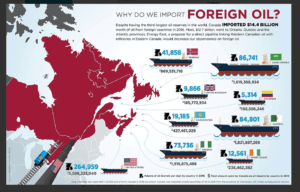The Oil & Gas industry has more than its fair share of misinformation directed at it. This site is intended to expose and explore facts and so as part of our new series on the Oil & Gas industry we thought you would like a quick run down of some interesting facts:
- LNG Does Not Burn: Companies compress Natural Gas into what is known as Liquified Natural Gas (LNG) it is much easier to move and store. However, one concern that is often heard relates to how dangerous LNG (think of an LNG tanker as a floating bomb or an LNG pipeline as scary torch), but LNG is safer than nearly any other petroleum product. It will not burn and if it spills it LNG will quickly clean itself up. LNG is incredibly safe. Watch this short fun video:
.
- Bituman Balls Are Coming Soon: Tar / Oil sands can now be easily turned into ‘blocks’ and transported in trucks or possibly even pipelines. So called ‘Bituman Balls’ are virtually spill proof and even float so they can be easily cleaned up in the event of an accident.
https://www.youtube.com/watch?v=YnFgIZpzcUY
.  Canada Imports Huge Amounts of Oil From The Middle East & Africa: Despite the fact the Canada has the third largest proven oil reserves in the world, it imports many billions of dollars in middle eastern oil every year. Nearly all of this is consumed in Ontario and Quebec. Is it not obviously better for the environment to pipe oil and gas from Alberta than it is to extract, truck, pipe and then tanker massive amounts of oil from the other side of the globe?
Canada Imports Huge Amounts of Oil From The Middle East & Africa: Despite the fact the Canada has the third largest proven oil reserves in the world, it imports many billions of dollars in middle eastern oil every year. Nearly all of this is consumed in Ontario and Quebec. Is it not obviously better for the environment to pipe oil and gas from Alberta than it is to extract, truck, pipe and then tanker massive amounts of oil from the other side of the globe?
.- Your Car Produces 75% of GHG’s: While some Green House Gases (GHGs) are emitted in the extraction phase of the crude oil production process, most of the life cycle emissions of fuel come from a vehicle’s tailpipe. In fact combustion of gasoline and diesel from your tailpipe accounts for approximately 75% emissions. These vehicle emissions are the same, regardless of the crude oil from which the gasoline is derived (like the tar/oil sands or conventions wells). Source: Government of Canada
. - 80% of New Oil Sands Production Has Its Water Recycled: Most water used in oil sands development is recycled – 80 percent for established mining operations and approximately 94 percent for in-situ recovery. Source: Government of Canada
. - Oil & Gas Pipelines Are 4.5 Times Safer Than Rail: Oil & Gas pipelines are not only safe, they are really just core infrastructure that are re-purposed, extended and have even their direction reversed. They should be thought more of as a highway. Today oil and gas pipelines can be quickly converted to move fresh water tomorrow.
. - Oil Sands Will Have a 65% Reduction in Green House Gas By 2027: By converting energy and by-product into electricity that would otherwise be waste, co-generation has already contributed significantly to the 30% decrease GHG emissions seen in the oil sands in the last decade. Cenovus is one of the largest oil sands producers and they expect to reduce their GHG’s by an additional 30%, for a total of 65% reduction of 2007 emissions by 2027.
. - Autonomous Vehicles Will Be Used In The Oil Industry First: Suncor will be one of the worlds first large scale users of autonomous vehicles in 2019. In January 2018 Suncor announced they have ordered 150 autonomous haul trucks. This move should not only increase efficiency and decrease cost, but also make a dangerous job much safer.
. - Oil Exploration Is Much Imporved: Oil and Gas are often found with the use of large scale Seismic Surveys which involve cutting hundreds of kilometers of “lines” through the forest. Until about 2005 this often involved using massive machines to clear massive amounts of forest but today those lines are often no wider than 8 feet and will regrow to the point you can not see the lines in just 4 years.
. - 100% of Oil Sands Land Will Be Reclaimed: The Alberta Oil Sands are often thought of a giant clean up project. In fact, this is true but in the opposite direction to what you are likely thinking. The land in the Tar / Oil Sands is literally full of oil near the surface which leaches into the water supply and makes constructing buildings difficult. While any large scale industry has an impact on the environment, oil sands companies are required by both Provincial AND Federal law to clean up 100% of that environment. Because the Alberta oil sands are relatively new and still under development, there are many very ugly pictures to look at but the fact is that that once the oily sand removed, the land will be planted with grasses and trees.
- LNG Does Not Burn: Companies compress Natural Gas into what is known as Liquified Natural Gas (LNG) it is much easier to move and store. However, one concern that is often heard relates to how dangerous LNG (think of an LNG tanker as a floating bomb or an LNG pipeline as scary torch), but LNG is safer than nearly any other petroleum product. It will not burn and if it spills it LNG will quickly clean itself up. LNG is incredibly safe. Watch this short fun video:
For more in this series see:



0 Comments